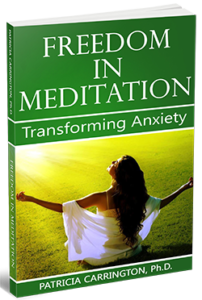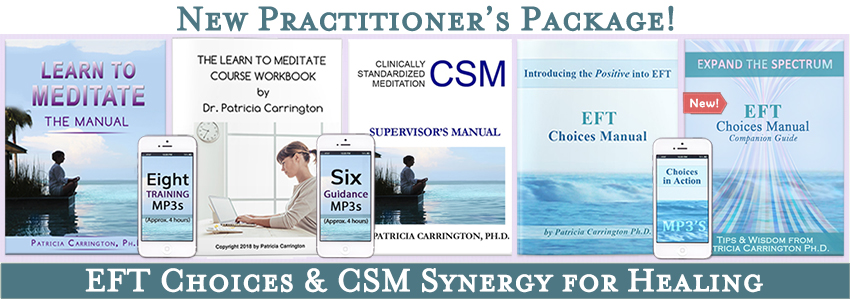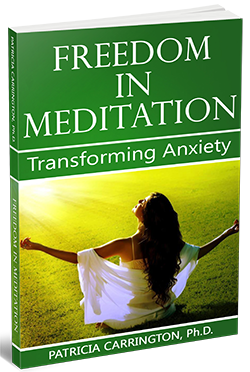
The award-winning Clinically Standardized Meditation (CSM) method of non-directive meditation is recognized by medical authorities and corporations worldwide for its effectiveness and extreme ease of use.
It’s a major clinical meditation technique in the world — so simple to learn that it can be mastered within one week of using the Learn to Meditate Course.
The Complete Learn to Meditate System includes everything in The Learn to Meditate Course, which contains 8 training audios (MP3s) consisting of nearly 4 hours of guiding instruction from Dr. Patricia Carrington, the Manual (75-page PDF), a Course Workbook (Mobile Friendly Interactive 42-page PDF) and the Freedom in Meditation eBook
In the training audios, Dr. Carrington is your teacher and her voice provides a blend of authority, genuineness and warmth, which makes learning CSM a unique and powerful experience.
The Learn to Meditate Manual, combined with the Course Workbook provides step-by-step instruction
The Instruction Manual
- Learn to Meditate Manual
- Your step-by-step instruction in CSM, along with a wealth of helpful information on a broad array of topics relating to meditation
- Special considerations: Medical issues, meditating teens, meditating couples
- Handling typical problems that may arise during mediation
- Best times of day for meditating
- Timing your meditation
- Best posture during meditation
- Selecting and using your mantra
- Reducing tension arising from tension-release while meditating
- Special problems and exceptional circumstances during a meditation session
- Combining exercise and meditation
The Interactive Course Workbook
- The Course Workbook
- “Progress Questionnaires” with accompanying advisory pages to assist you in troubleshooting any difficulties you might face while learning CSM.
- Additional materials, such as daily meditation checklists, meditation timing and scheduling charts, help you keep track of your meditation experiences and improve your meditation practice. These can be also used as a valuable resource for future reference, once you become an experienced meditator.
- Interactive form elements so you can type directly into the questionnaires and charts, using Adobe Acrobat Reader DC, on your computer, tablet, or Smartphone. (You can also choose to print the PDFs and work with them manually)
The Audio Training
- The Eight Training Audios
The Eight Training Audios consist of nearly 4 hours of instruction directly by Dr. Patricia Carrington:
- Introductory Talk 1: Explains the meditation process (22:29 min.)
- Introductory Talk 2: Describes the benefits of meditation (23:35 min)
- Day 1: BASIC INSTRUCTION (28:51 min)
- Day 1: Post Meditation Discussion Session (28:52 min)
- Day 2: How to live with meditation (26:22):
- Meditating by yourself
- What to do if interrupted during meditation
- Meditation scheduling and routines
- Your meditation environment
- Day 9 Meditation Guidance & FAQs (28:39 min):
- Advice about making comparisons to meditation experiences of others
- Noticing your progress as you go along
- Trusting your inner time-table
- Cautions against over-meditating
- When you meditate more often
- Using meditation when you are highly anxious
- Using meditation to help regulate high blood pressure
- Meditation as an adjunct to regulating high blood pressure
- Meditating while lying down
- Using meditation to induce restful sleep
- Moving to the next level
- Commencing meditation again after a hiatus
- Meditation for Enhancing Life (27:34 min.)
- Finding time to meditate in a busy life
- How to use the Rest-Activity Cycle (RAC)
- Scattering Mini-Meditations throughout your day
- New York Telephone’s program in CSM (research study)
- Guided session for renewing your meditation practice

The Freedom in Meditation (PDF), formerly entitled The Book of Meditation, answers a host of questions not previously addressed by any other book and covers all aspects of the practice – such as the relevance of different techniques, the clinical uses of meditation and the psychological and physical effects – making it an invaluable guide for the beginner and experienced meditator alike.
Table of Contents
- PART 1 - Science Explores Meditation
- The Start of the Journey - I Learn to Meditate / My Husband Joins the ‘Club’ / The Birth of Clinically Standardized Meditation / The Family of Practices
- The Ageless Practice - The Techniques / Meditation Versus Centering / Transcendental Meditation (TM) / Clinically Standardized Meditation (CSM) / Benson’s Method / Other Methods
- Is Meditation Unique? - Religious Meditation and Prayer / Self-Hypnosis / Autogenic Training / Free Association / Progressive Relaxation / Biofeedback
- The Scientist Takes Note - Studying the Masters / The Modern Research / Studies on the Physiology of Meditation / Brain Waves During Meditation / GSR During Meditation / Psychological Effects
- The Other Side of Research - Wallace’s Work Seen Differently / Basic Designs / Tracking Down the ‘Placebo’ / The Search for the Opposite / How Dropouts Affect Meditation Research / Where We Stand
- PART 2 - Managing Meditation
- Learning How to Meditate - Preparation / Attitude / Mantra Meditation / Meditation on Breathing / Moving Meditation / Visual Meditation / Comments / Meditating as a Regular Practice / Others’ Experiences
- The Challenge of Tension-Release - Tension-Release Side-Effects / Relation of Tension- Release to Life History / The Management of Tension-Release / Reducing Meditation Time / Progressive Change / The Resolution of Tension-Release / Techniques for Handling Persistent Side- Effects / Temporary Setbacks
- How to Use Meditation Under Stress - Mini-Meditations / Preparatory Meditation / Meditation and Exam Anxiety / Pre-Surgical Meditation / Meditation to Counteract Phobias / Meditating Athletes / Blasdall’s Star Tracers / Rimol’s Labyrinth Players / Unanswered Questions / Extra Meditation / Meditating When Ill / Meditation During Prolonged Emotional Stress / Alternating Meditation with Rest / Meditation Under Catastrophic Circumstances / Relaxation Under Physical Stress / Meditation and Self-Suggestion
- Some Intriguing Rhythms - Bodily Cycles / Morning Versus Evening Meditation / Meditation ‘Readiness’ / Yoga Scheduling / The Basic Ultradian Rhythm / Exploring a DayDr.eam Cycle / The Oral Activity Cycle / The DayDr.eam Cycle Revisited / An Ultradian Rhythm for Meditation? / Influences of External Rhythms / Solar Rhythms / The Sun’s Influence on the Body / Instructions to Meditate Morning and Afternoon / Adrenal Hormones and Morning Meditation / REM Sleep as Stress State / Varying the Morning Hour / Late Afternoon and Bedtime Meditation / Where We Stand on Timing
- The Mystery of the Mantra - Impact of Sound / The Effects of Specific Sounds / The Traditional Use of Mantras / The Admonition of Secrecy / Ancient Views on Revealing the Mantra
- A Few Nagging Questions - Correct Postures for Meditating / Vacations from Meditation / Suiting the Technique to the Person / Atmosphere of Instruction
- A New Partnership - The Hartford Experience / Reducing Anxiety / Combating Addiction / Why Is Meditation Anti-Addictive? / Combating Physical Illness / Counteracting Insomnia
- More Open to Life - A Repression Lifts / Sense of Self Increases / Greater Openness to Others
- The Creative Meditator - Increased Productivity / Improved Quality of Creative Work / Strengthening of Staying Power
- Some Problems Arise - Refusal to Learn Meditation / Those Who Learn Then Quit / Resistance of Self-Image to Change / Depression and Meditation / Fear of Pleasure
- The Misuse of Meditation - Problems from Over-Meditation
- A Therapist’s View - How Deep Does Meditation Go? / Is Meditation Psychotherapy? / The Meditating Therapies
- Meditation in the Workplace - New York Telephone Adopts CSM / Management Takes Note
- Why Does Meditation Work? - Taking the Charge Off Negative Emotions
/ Breaking Up Old Patterns / Balancing the Two Sides of the Brain / Reducing Sensory Overload / Rediscovering Natural Rhythms / The Lessons of Meditation / The Lesson of Self-Acceptance - The Promise of the Future - In Medicine / In Psychotherapy / In Education
/ In Business and Industry / Meditation in the Future / Toward a New Perspective
- PART 3 - Meditation and Personal Growth
- A New Partnership - The Hartford Experience / Reducing Anxiety / Combating Addiction / Why Is Meditation Anti-Addictive? / Combating Physical Illness / Counteracting Insomnia
- More Open to Life - A Repression Lifts / Sense of Self Increases / Greater Openness to Others
- The Creative Meditator - Increased Productivity / Improved Quality of Creative Work / Strengthening of Staying Power
- Some Problems Arise - Refusal to Learn Meditation / Those Who Learn Then Quit / Resistance of Self-Image to Change / Depression and Meditation / Fear of Pleasure
- The Misuse of Meditation - Problems from Over-Meditation
- A Therapist’s View - How Deep Does Meditation Go? / Is Meditation Psychotherapy? / The Meditating Therapies
- Meditation in the Workplace - New York Telephone Adopts CSM / Management Takes Note
- Why Does Meditation Work? - Taking the Charge Off Negative Emotions
/ Breaking Up Old Patterns / Balancing the Two Sides of the Brain / Reducing Sensory Overload / Rediscovering Natural Rhythms / The Lessons of Meditation / The Lesson of Self-Acceptance - The Promise of the Future - In Medicine / In Psychotherapy / In Education
/ In Business and Industry / Meditation in the Future / Toward a New Perspective
- PART 4 - Conclusions
- Why Does Meditation Work? - Taking the Charge Off Negative Emotions
/ Breaking Up Old Patterns / Balancing the Two Sides of the Brain / Reducing Sensory Overload / Rediscovering Natural Rhythms / The Lessons of Meditation / The Lesson of Self-Acceptance - The Promise of the Future - In Medicine / In Psychotherapy / In Education
/ In Business and Industry / Meditation in the Future / Toward a New Perspective
- Why Does Meditation Work? - Taking the Charge Off Negative Emotions
The Complete Learn to Meditate System
$69.95
Reduced Price! – $39.00
- Medical Disclaimer
CSM does not constitute a replacement for treatment by a competent health care professional for patients suffering from physical or emotional symptoms requiring therapeutic intervention. In particular, people who are receiving medication for endocrine or metabolic control or for the control of pain or of psychiatric symptoms, should be under the care of a health professional familiar with the effects of profound relaxation upon medical conditions and drug therapy. Keep in mind that persons using insulin, thyroxin or anti-hypertensive medications, in particular, may require decreases in dosage of these drugs while engaging in the regular practice of CSM, and their physicians should be asked to read the Information Sheet for Doctors (Included in the Preparations Instruction PDF).







